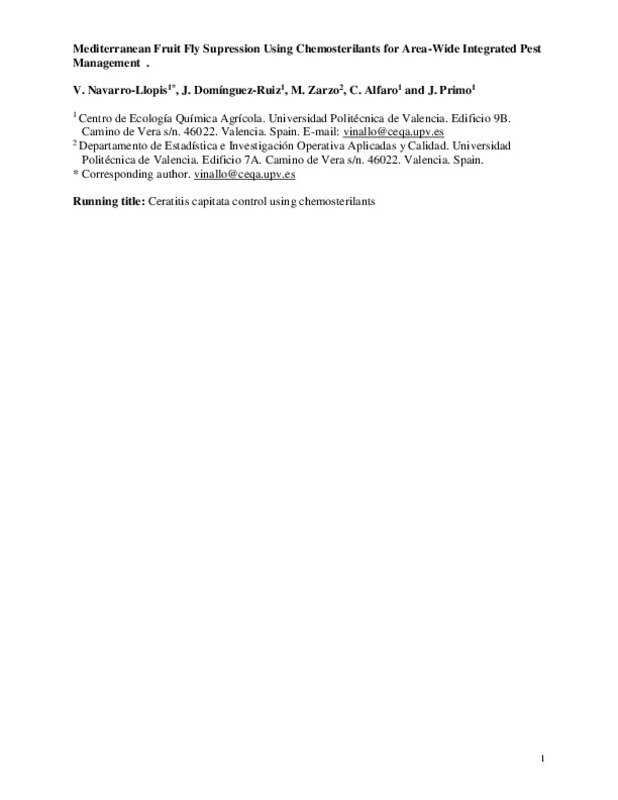Magaña, C., Hernández-Crespo, P., Ortego, F., & Castañera, P. (2007). Resistance to Malathion in Field Populations of Ceratitis capitata. Journal of Economic Entomology, 100(6), 1836-1843. doi:10.1093/jee/100.6.1836
Peck, S. L., & McQuate, G. T. (2000). Field Tests of Environmentally Friendly Malathion Replacements to Suppress Wild Mediterranean Fruit Fly (Diptera: Tephritidae) Populations. Journal of Economic Entomology, 93(2), 280-289. doi:10.1603/0022-0493-93.2.280
DeLury, N. C., Thistlewood, H., & Routledge, R. (2009). Phytotoxicity of GF-120®NF Naturalyte®fruit fly bait carrier on sweet cherry (Prunus aviumL.) foliage. Pest Management Science, 65(1), 52-59. doi:10.1002/ps.1644
[+]
Magaña, C., Hernández-Crespo, P., Ortego, F., & Castañera, P. (2007). Resistance to Malathion in Field Populations of Ceratitis capitata. Journal of Economic Entomology, 100(6), 1836-1843. doi:10.1093/jee/100.6.1836
Peck, S. L., & McQuate, G. T. (2000). Field Tests of Environmentally Friendly Malathion Replacements to Suppress Wild Mediterranean Fruit Fly (Diptera: Tephritidae) Populations. Journal of Economic Entomology, 93(2), 280-289. doi:10.1603/0022-0493-93.2.280
DeLury, N. C., Thistlewood, H., & Routledge, R. (2009). Phytotoxicity of GF-120®NF Naturalyte®fruit fly bait carrier on sweet cherry (Prunus aviumL.) foliage. Pest Management Science, 65(1), 52-59. doi:10.1002/ps.1644
Hargrove, J. W., & Langley, P. A. (1990). Sterilizing tsetse (Diptera: Glossinidae) in the field: a successful trial. Bulletin of Entomological Research, 80(4), 397-403. doi:10.1017/s0007485300050653
Langley, P. A. (1995). Evaluation of the chitin synthesis inhibitor triflumuron for controlling the tsetse Glossina morsitans morsitans (Diptera: Glossinidae). Bulletin of Entomological Research, 85(4), 495-500. doi:10.1017/s0007485300032971
Sarasua, M. J., & Santiago-Alvarez, C. (1983). Effect of diflubenzuron on the fecundity of Ceratitis capitata. Entomologia Experimentalis et Applicata, 33(2), 223-225. doi:10.1111/j.1570-7458.1983.tb03260.x
Budia, F., & Viñuela, E. (1996). Effects of Cyromazine on Adult C. capitata (Diptera: Tephritidae) on Mortality and Reproduction. Journal of Economic Entomology, 89(4), 826-831. doi:10.1093/jee/89.4.826
Oouchi, H., & Langley, P. (2005). Control of Greenhouse Whitefly (Trialeurodes vaporariorum) Using Visually Attractive Targets Impregnated with Pyriproxyfen. Journal of Pesticide Science, 30(1), 50-52. doi:10.1584/jpestics.30.50
Richardson, M. L., & Lagos, D. M. (2007). Effects of a juvenile hormone analogue, pyriproxyfen, on the apterous form of soybean aphid (Aphis glycines). Journal of Applied Entomology, 131(5), 297-302. doi:10.1111/j.1439-0418.2007.01163.x
Zapata, N., Budia, F., Viñuela, E., & Medina, P. (2006). Laboratory evaluation of natural pyrethrins, pymetrozine and triflumuron as alternatives to controlCeratitis capitata adults. Phytoparasitica, 34(4), 420-427. doi:10.1007/bf02981029
Casaña-Giner, V., Gandía-Balaguer, A., Mengod-Puerta, C., Primo-Millo, J., & Primo-Yúfera, E. (1999). Insect Growth Regulators as Chemosterilants for Ceratitis capitata (Diptera: Tephritidae). Journal of Economic Entomology, 92(2), 303-308. doi:10.1093/jee/92.2.303
Navarro-Llopis, V., Sanchis-Cabanes, J., Ayala, I., Casaña-Giner, V., & Primo-Yúfera, E. (2004). Efficacy of lufenuron as chemosterilant againstCeratitis capitata in field trials. Pest Management Science, 60(9), 914-920. doi:10.1002/ps.902
Navarro-Llopis, V., Sanchis, J., Primo-Millo, J., & Primo-Yúfera, E. (2007). Chemosterilants as control agents of Ceratitis capitata (Diptera: Tephritidae) in field trials. Bulletin of Entomological Research, 97(4), 359-368. doi:10.1017/s0007485307005081
Muñoz-Pallares, J., Corma, A., Primo, J., & Primo-Yufera, E. (2001). Zeolites as Pheromone Dispensers. Journal of Agricultural and Food Chemistry, 49(10), 4801-4807. doi:10.1021/jf010223o
Domínguez-Ruiz, J., Sanchis, J., Navarro-Llopis, V., & Primo, J. (2008). A New Long-Life Trimedlure Dispenser for Mediterranean Fruit Fly. Journal of Economic Entomology, 101(4), 1325-1330. doi:10.1093/jee/101.4.1325
Navarro-Llopis, V., Alfaro, F., Domínguez, J., Sanchis, J., & Primo, J. (2008). Evaluation of Traps and Lures for Mass Trapping of Mediterranean Fruit Fly in Citrus Groves. Journal of Economic Entomology, 101(1), 126-131. doi:10.1093/jee/101.1.126
Abbott, W. S. (1925). A Method of Computing the Effectiveness of an Insecticide. Journal of Economic Entomology, 18(2), 265-267. doi:10.1093/jee/18.2.265a
Knipling, E. F. (1972). ENTOMOLOGY AND THE MANAGEMENT OF MAN’S ENVIRONMENT. Australian Journal of Entomology, 11(3), 153-167. doi:10.1111/j.1440-6055.1972.tb01618.x
Mangan, R. L., Moreno, D. S., & Thompson, G. D. (2006). Bait dilution, spinosad concentration, and efficacy of GF-120 based fruit fly sprays. Crop Protection, 25(2), 125-133. doi:10.1016/j.cropro.2005.03.012
Hargrove, J. W., & Langley, P. A. (1993). A field trial of pyriproxyfen-treated targets as an alternative method for controlling tsetse (Diptera: Glossinidae). Bulletin of Entomological Research, 83(3), 361-368. doi:10.1017/s0007485300029254
Asquith, A., & Messing, R. H. (1992). Attraction of Hawaiian Ground Litter Invertebrates to Protein Hydrolysate Bait. Environmental Entomology, 21(5), 1022-1028. doi:10.1093/ee/21.5.1022
Hoelmer, K. A., & Dahlsten, D. L. (1993). Effects of Malathion Bait Spray on Aleyrodes spiraeoides (Homoptera: Aleyrodidae) and Its Parasitoids in Northern California. Environmental Entomology, 22(1), 49-56. doi:10.1093/ee/22.1.49
Berrada, H., Fernández, M., Ruiz, M. J., Moltó, J. C., & Mañes, J. (2006). Exposure assessment of fruits contaminated with pesticide residues from Valencia, 2001– 03. Food Additives and Contaminants, 23(7), 674-682. doi:10.1080/02652030600599132
Hendrichs, J., Robinson, A. S., Cayol, J. P., & Enkerlin, W. (2002). MEDFLY AREAWIDE STERILE INSECT TECHNIQUE PROGRAMMES FOR PREVENTION, SUPPRESSION OR ERADICATION: THE IMPORTANCE OF MATING BEHAVIOR STUDIES. Florida Entomologist, 85(1), 1-13. doi:10.1653/0015-4040(2002)085[0001:masitp]2.0.co;2
[-]






![[Cerrado]](/themes/UPV/images/candado.png)



